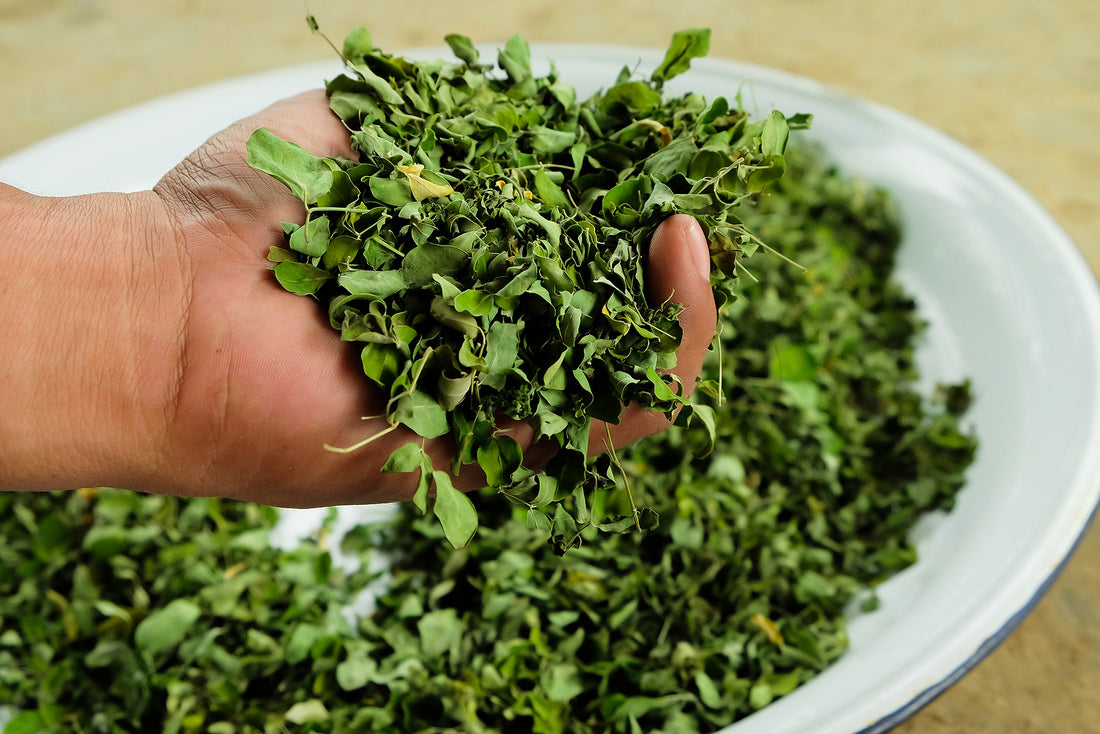Herbs are a powerful way to incorporate healing plants into your life. And there’s never been an easier way to enjoy them!
Moringa oleifera, or Moringa or short, is one such herb. This tree family of 13 different species has a few other names you might be familiar with: Drumstick tree, horseradish tree, benzolive tree, and ben oil tree (3).
Also known as the miracle tree, this hardy plant can be found in areas of India, South America, and the regions of Africa. Its slender trunk and small, oval leaves help it to efficiently handle long periods of drought. This comes in handy, especially during dry seasons where rainfall is few and far between.
What is Moringa Good For?
Traditionally, Moringa was valued for its many nutritional, medicinal, and industrial uses. For example, the oil extracted from seeds was used to protect the skin and make perfumes (1).
Today, it’s hailed to be an important part of healthy living. In developing countries, the leaves and pods of the Moringa tree are used to fight malnutrition in developing countries (4). How does this tree provide nutrients for its community?
You wouldn’t know it at first glance, but the leaves contain protein, sulfur, vitamins, and minerals that your body needs to function at its best. In fact, according to research, Moringa leaves have more Vitamin C than oranges, more potassium than bananas, and more Vitamin A than carrots (2)!
Benefits
Our ancestors used Moringa to help treat a variety of ailments, including labor pains, burns, asthma, constipation, and wound healing. But does science back up any of these claims?
Certain elements of the plant also seem to contain anti-inflammatory properties, which could be beneficial in:
- Lower blood pressure: Chronic high blood pressure can lead to heart disease, which is why it’s important to address contributing factors. Research suggests a positive correlation between taking Moringa extract and lowered blood pressure levels (11).
- Lower bad cholesterol levels: The antioxidant properties of Moringa have been used in traditional Thai medicine to help heart health. Research finds it also has hypolipidemic activities, which can lower cholesterol and keep your arteries flowing clean and clear (6).
- Reduce chronic inflammation: Inflammation is your body’s response to injury, but chronic inflammation can increase your risk for health concerns. Moringa contains isothiocyanates, antioxidant compounds that can help cool chronic inflammation in the body, reducing these risks (8).
- Protect against arsenic poisoning: If your diet consists of eating a lot of rice, there’s a risk of arsenic building up in your system, causing health problems down the road. Studies find that consuming Moringa seeds and leaves may offer protection against arsenic damage (7).
Risks and Side Effects
The few human studies that have been done haven’t reported many adverse side effects (9). Even so, like with many other herbs, taking too much Moringa could results in:
- Digestive upset
- Loose stools
- Nausea
While Moringa does have an incredible nutrient profile, it also contains compounds that could prevent you from absorbing nutrients properly, such as tannins, nitrates, and oxalic acid (5).
Because of its potential to lower cholesterol and blood pressure, Moringa may not be good taken with medication. Consult with your doctor if you’re pregnant or breastfeeding.
Ways to Take Moringa
In its natural state, the roots, leaves, and pods are harvested for food and medicine.
Curious about trying Moringa for yourself? There are lots of ways you can add it to your routine. Depending on your lifestyle and personal preferences, you can find this herb in the form of:
- Capsules
- Powder
- Tea
Tree Care
Thinking about keeping your own Moringa tree around? If cared for properly, it’s a great way to reap the benefits of this herb on a regular basis.
How do you plant and care for a Moringa tree? Here are some basics tips (10):
Temperature
If you live in a tropical or subtropical climate, you can get away with leaving your Moringa tree outside all year around. Once established, they can handle temperatures of up to 118 degrees Fahrenheit. If you live in cooler climates, you will need to bring your Moringa tree inside during winter months.
Moringa trees will grow best in zones 10 and 11.
Light
Plant your Moringa tree in areas of direct sunlight. Partial or full shade areas may stunt the tree’s growth.
Soil
Moringa trees are hardy and will adapt to different types of soils. Ideally, you’ll want sandy, well-draining soil.
Water
Be careful not to overwater your newly planted Moringa tree. They like to stay moist, but overwatering can lead to “wet feet” which could drown the roots.
Fertilizer
Adding compost to your soil is a great way to add extra nutrients to your Moringa tree. Once the plant is established, you won’t need to keep fertilizing year after year.
Back to You
Moringa is a diverse plant that has been used for thousands of years. The leaves, roots, and pods are consumed as food, used as medicine, and included in cultural events.
Research has made some exciting discoveries on the ways Moringa can benefit your health. This miracle herb has incredible nutritional value, contains antioxidants and anti-inflammatory properties, and may help lower blood pressure and cholesterol levels.
Even with minimal known side effects, it’s still important to speak with your doctor if you’re taking blood pressure or cholesterol medication. The same rule applies if you have other health conditions, are pregnant or are breastfeeding.
Are you curious about trying Moringa? Let us know today!
References & Disclaimers
1. https://www.ncbi.nlm.nih.gov/pmc/articles/PMC5958191/
2. https://pubmed.ncbi.nlm.nih.gov/31692437/
4. https://pubmed.ncbi.nlm.nih.gov/25808883/
5. https://pubmed.ncbi.nlm.nih.gov/24206684/
6. https://pubmed.ncbi.nlm.nih.gov/18249514/
7. https://pubmed.ncbi.nlm.nih.gov/25183111/
8. https://pubmed.ncbi.nlm.nih.gov/20685125/
9. https://onlinelibrary.wiley.com/doi/10.1002/ptr.5325
10. https://www.thespruce.com/how-to-grow-and-care-for-moringa-plants-5076022
11. https://pubmed.ncbi.nlm.nih.gov/30668387/
✝✝This noted statement is based on independent research and is not necessarily the opinion of the author
